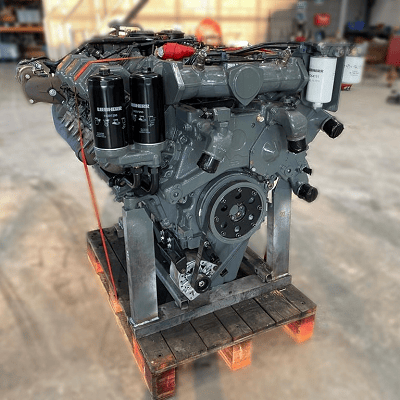The process of a dyno test on a Liebherr engine

When it comes to heavy machinery, reliability and power are paramount. Liebherr, a name synonymous with innovation and excellence in engineering, stands tall as a pioneer in the realm of heavy equipment and machinery. From towering cranes to robust excavators, Liebherr’s engineering prowess extends to the heart of these machines. We delve into the world of dyno testing a Liebherr engine, uncovering the meticulous process behind unleashing the raw power concealed within.
The foundation of excellence
Before we embark on the journey of dyno testing, it’s crucial to understand the foundation upon which Liebherr engines are built. With decades of engineering expertise and commitment to quality, Liebherr engines are crafted to withstand the most demanding environment and deliver unparalleled performance. Each component is meticulously designed and rigorously tested to ensure reliability, efficiency and longevity.
The process
1 Preparation: The engine undergoes meticulous preparation before being mounted onto the dynamo meter. This includes ensuring all connections are secure, fluids are filled to the appropriate levels, and sensors are properly calibrated.
2 Mounting: The engine is carefully mounted onto the dynamometer, a specialized device designed to simulate real-world operating conditions. Precision is paramount during this step to ensure accurate results.
3 Initial checks: Once mounted, a series of initial checks are conducted to verify proper alignment, connection integrity, and functionality of all engine systems.
4 Warm-up: The engine is started and allowed to warm up to operating temperature. This ensures consistent results and minimizes the risk of damage during testing.
5 Baseline testing: With the engine warmed up , baseline tests are conducted to establish initial performance metrics. This includes measuring power output, torque, fuel consumption, and emissions at various RPM levels.
6 Load testing: The engine is subjected to progressively increasing loads to simulate different operating conditions, such as idle, partial load and full load. This allows engineers to assess performance across the entire operating range and identify any potential issues or optimization.
7 Data analysis: Throughout the testing process, data is continuously collected and analyzed in real-time. Advanced instrumentation and software are used to monitor performance metrics and identify trends or anomalies.
8 Optimazation: Based on the data analysis, adjustments may be made to optimize engine performance. This could involve fine-tuning fuel injection timing, adjusting air-fuel ratios, or optimize turbocharger boost pressure.
9 Validation: Once testing is complete, the results are meticulously reviewed and validated against predetermined criteria and specifications. Any deviations or anomalies are thoroughly investigated to ensure accuracy and reliability.
10 Reporting: Finally, a comprehensive report is generated detailing the results of the dyno testing, including performance metrics, observations, and any recommendations for further optimization or refinement.
The outcome of dyno testing
Dyno testing a Liebherr engine is more than just a routine procedure – it’s a testament to the unwavering commitment to excellence that defines Liebherr’s engineering philosophy. By subjecting their engines to rigorous testing and analysis, Liebherr ensures that each engine delivers the uncompromising performance, reliability, and efficiency that customers expect.
In conclusion, dyno testing a Liebherr engine is not just about measuring power output. It’s about unlocking the true potential of these remarkable engines and ensuring they exceed expectations in the most challenging environments imaginable.
Waste Tyre And Plastic Pyrolysis Machine
A pyrolysis machine, also known as a thermal depolymerization or pyrolysis reactor, is a device that converts organic materials, such as waste plastics, rubber, biomass, or agricultural waste, into useful products through a process called pyrolysis. Here's a general overview of how a pyrolysis machine works:
1. **Feedstock preparation**: The raw material is first collected, sorted, and prepared for the process. It may be shredded, crushed, or ground to facilitate better contact with heat.
2. **Loading and sealing**: The prepared material is loaded into the reactor, which is typically a sealed, high-temperature vessel. This is done under controlled conditions to prevent oxygen from entering, as it would interfere with the pyrolysis reaction.
3. **Heating:** A heating source, usually an electric resistance or a combination of oil/gas, is used to raise the temperature inside the reactor. The temperature can range from 400°C to 1200°C, depending on the type of feedstock and desired products.
4. **Pyrolysis reaction**: As the temperature rises, the organic material breaks down into simpler compounds without oxygen present. This process involves the breaking of chemical bonds, leading to the formation of gases (hydrocarbons like methane, carbon dioxide, and hydrogen), oils (furnace oil), and solid char (a carbon-rich residue).
5. **Gas separation and purification:** The gaseous products are passed through a cooling system, where they condense into a liquid phase. This liquid, called pyrolysis oil, contains valuable hydrocarbons that can be further refined for use as fuel or chemicals. The gas mixture is also separated to remove non-condensable gases and combustible materials, which can be burned for energy.
6. **Char handling:** The solid char, which has a lower energy value, is typically disposed of or used as a soil conditioner, or further processed for other applications like carbon black in rubber or concrete production.
7. **Product collection and storage:** The purified gases, pyrolysis oil, and char are collected and stored separately for further processing or sale.
8. **Effluent treatment**: The machine may include filters and scrubbers to minimize emissions and ensure compliance with environmental regulations.
waste tyre pyrolysis plant,tyre pyrolysis equipment ,recyling distillation plant ,oil distillation plant,waste engine oil distillation machines
SHANGQIU FLAT WORLD MACHINERY CO.,LTD , https://www.flateuropeantruck.com